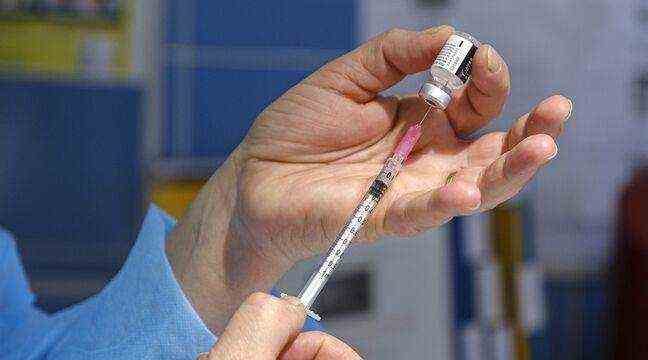A dose of a vaccine against Covid-19. – Bony / SIPA
- While the vaccine doses keep opening up to new sections of the population, the French vaccine campaign seems to be reaching a cruising speed and continued acceleration.
- Finally, because between the mistrust of AstraZeneca, the delays in deliveries and the government’s groping, the objectives of the executive did not always seem tenable.
- Where are we in achieving these objectives – 20 million in mid-May, 30 million in mid-June – this Tuesday?
Each week, the government hammers out its objectives in the vaccination campaign: 10 million people who received at least one dose in mid-April – target achieved -, 20 million in mid-May and 30 million in mid-June. In order to speed up the vaccination campaign, reservation windows are constantly opening up for new populations. This Tuesday, any adult, even without comorbidity, can register for vaccination and receive a dose if it has not found a taker within 24 hours in priority audiences (people over 50 years of age or with comorbidities) .
Are this desired acceleration and these stated objectives achievable? We take stock.
Is the current vaccination rate sufficient?
The average first-time injection over the past week is 266,200 daily doses. This rate would make it possible to have 19.5 million first-time vaccinated on May 15, and to reach the symbolic bar of twenty million on May 17. At this rate, 27.8 million would be vaccinated on June 15, and 30 million would be reached on June 21. By not quibbling too much, we can say that the current pace is sufficient.
The whole question is whether the pace will stop there, speed up or slow down. In recent weeks, it has tended to accelerate significantly. But the question of doses arises. Asked by the Sunday Newspaper, Stanislas Niox-Chateau, boss of DoctoLib explained: “We now vaccinate just in time: 2.8 million doses of Pfizer-BioNTech and Moderna arrive each week in France, and 2.7 million French people are vaccinated each week. The limiting factor remains the number of doses: if we had them, we would have exploded the 20 million ”.
What to do with AstraZeneca?
If the question arises today, it is because of the AstraZeneca vaccine. Cause of many worries, in particular a few cases of thrombosis listed, the vaccine is found “shunned” by those over 55 (and is prohibited to the rest of the population). Between mid-March and this week, the number of AstraZeneca injections fell from over 100,000 per day on average to less than 30,000. There were still over 75,000 daily injections as of mid-April. Since then, it is the tumble.
So much so that barely 56% of the 7,395,000 doses received in total, including two million on May 9, have been used. In comparison, as mentioned by Stanislas Niox-Chateau, Pfizer-BioNtech and Moderna sell more than 90% of their stocks. The “good” news is that from May 9, AstraZeneca should deliver “only” seven million additional doses, against thirty million from Pfizer-BioNtech and more than four million from Moderna in May and June, according to the calendar of the Ministry of Health delivered this Tuesday.
Will there be enough doses?
Pfizer-BioNtech, the most popular vaccine, will have finally delivered to France 47.9 million doses in the first half, against 26 million initially planned. In total in June, France will have received 54.6 million doses of messenger RNA vaccine, more popular and without side effects like AstraZeneca or Jansen, almost enough to double vaccinate 30 million French people.
“With all these deliveries planned, I do not see how the rate of vaccination could slow down, despite the mistrust of AstraZeneca”, indicates Marie-Aline Bloch, researcher in management sciences at the School of Advanced Studies in Public Health and specialist in French health system. She adds: “At worst, the disenchantment with AstraZeneca will lead to a smaller increase in the vaccination rate, but there will be an acceleration all the same”. Stanislas Niox-Chateau indicates in the JDD thus hope for 800,000 daily vaccinations at the end of June, due to the increase in doses.
The second doses will they slow down the first injections?
In February, the number of first-time injections had dropped drastically because of the second dose to be administered. Most of the doses delivered during the month used for this, slowing the progress of partially vaccinated people. But such a catastrophic scenario is now almost impossible to reproduce, as Marie-Aline Bloch explains: “The second dose has been reduced from four to six weeks for messenger RNA vaccines – Pfizer / BioNtech and Moderna, in order to accelerate the number of first injection. And the more the months go by, the more doses we receive, so much so that when it comes time to prick a person a second time, there are now more than enough doses to also do first-time injections. “Currently, nine million French people have received a dose and are awaiting a second. A figure well below the planned deliveries, and which should make it possible to continue a large number of first-time injections.
Can vaccination now be open to everyone?
No, and the government recalled this Tuesday, vaccination is not yet open to everyone. The 24-hour measure is only used to sell out more quickly the doses that do not find takers, but there are not enough doses to immunize everyone at the moment. Moreover, this Tuesday Doctolib guaranteed approximately 20,000 slots available per day with this reservation system for the same day or the next day. Vaccination for all, which affects 23 million people, will only begin on June 15.

